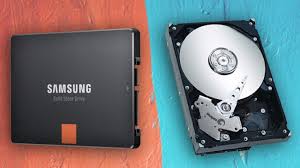When your computer is powered off, the operating system, your programs, and your data are preserved on non volatile storage. This has traditionally been in the form of a Hard Disk Drive (HDD), a sealed electro-mechanical unit consisting of magnetically coated platters which spin at high speed when powered on, and read/write heads on an arm to access the data. Newer computers use a Solid State Drive (SSD) instead of a HDD. SSDs perform the same function as a HDDs, non volatile storage while the computer is powered off, and access to data when the computer is powered on. The SSD is comprised of flash memory chips which can store information when powered off. SSDs using the Serial ATA bus to transfer data (just like HDDs) are packaged in the same shape as a 2.5" HDD, with the same SATA connector, so a HDD can be physically replaced by a SSD.

The SSD has two huge advantages over the HDD: speed and reliability. SATA SSDs offer transfer rates over 500 MBPS (megabits per second) which is up to 10 times faster than HDDs. Without any moving parts, the failure rate is significantly lower. A mid range Windows computer with a SSD will typically boot in 12 to 20 seconds. Your programs will load much faster with a SSD. Accessing the internet involves the computer storing lots of small files in a data cache on the computer's non volatile storage device. Because of all the read/write activity, internet surfing on a SSD equipped computer is much more robust than on a HDD equipped computer.
SSDs are more expensive than HDDs, so the typical SSD will have less capacity. But most computer users only use a small fraction of the capacity of their HDD, so capacity is usually not an issue.
You can upgrade from a HDD to a SSD. If you decide to pursue this upgrade, one option is to load a fresh version of the operating system on the SSD, reload all your programs, and transfer your data from the old HDD to the SSD. Alternatively, you may attempt to clone the old HDD to the new SSD. In this case, your new SSD is most likely a smaller capacity then your old HDD, so make sure that the cloning software is able to properly reformat the main data partition to the new smaller size. If your old HDD is in a tower chassis, it is most likely a 3.5" form factor, so you will need a mounting adapter for the 2.5" SSD.
Motherboards on newer computers support a newer type of SSD, form factor M.2. M.2 SSDs use newer NVMe (Non-Volatile Memory Express) storage connection standard which transfers using the much faster PCIe data transfer bus. PCIe 3 compatible SSDs can reach up to 3500 MBPS data transfer rate.
Even newer computers come with a PCie 4.0 data transfer bus which has significantly more bandwidth than PCIe 3.0. PCIe 4 compatible SSDs can reach up to 7000 MBPS data transfer rate.
As of this writing motherboards with a PCie 5.0 data transfer bus are starting to appear. PCIe 5 compatible SSDs can reach up to 12000 MBPS data transfer rate.
